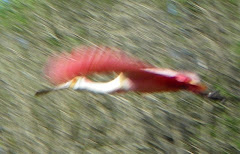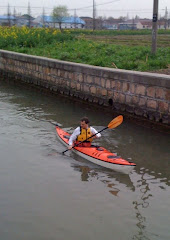In 1967 the British Canoe Union (BCU) magazine “Canoeing in Britain” published a Christmas competition with a prize of a copy of each of “Byde’s Books”. (In 1960 Alan Byde Alan later…
 |
| Alan Byde at his home in New Zealand 2006 |
In a country where people place bets on hounds chasing hares at up to 45 miles per hour... albeit electric hares... in 1967 a number of people wrote their dismay at a somewhat slower hare. The prominent sea kayaker Chris Hare
A 1967 advertisement for a sea kayak, the "Wessex Sea Rapier", demonstrated its on-land portability by showing it on the roof of a Morris 1,000 (1,000 cubic centimeters... and that's the engine not the cab)… a car that originally had little lighted orange pointers that swung out like arms from the supports between the side windows to indicate the direction of a turn! I'd like some on my kayak! In 1967, that fiberglass Sea Rapier cost just 36 pounds and 15 shillings… With today’s poor US dollar exchange value that’s about 74 dollars…
The 1967 magazine columns were full of quirky little revelations, such as “A Canadian is not really a sea going canoe”… and that by September 1967, two people had passed the "Advanced Canadian examination"… (You really have to look closely at these Canadians nowadays!)
Next… “The Senior coach is on a par with the Gold Medalist, and is a gentleman to be reckoned with” (Any women reading this?) This begs to be brought together with the declaration; “To all but a rhinoceros it must be obvious that the only place to learn to roll is the swimming baths – in this country anyway.” One can only imagine that the author had spotted the second appointed "BCU Senior (Rhino) Coach" on his back in his garden in Wolverhampton. This was apparently not an advanced Canadian exam!
In 1967, Hans Klepper Hans was associated with the design of the Klepper Arius in which Dr Hans Lindemann Skipping through the manufacturing processes from folding kayaks to plastic, Dave Mitchell
In this context, back to Alan , from the start of this piece… Alan wrote a great (truly) book titled “Living Canoeing” which published in 1969 and according to Alan was started in 1967. It is a classic book, with content mostly valid today. I can see how later writers have likely been influenced by the style of line drawings that illustrate many of the technical aspects, and by the content of the Sea Kayaking sections of the book. Not Byde’s first, or last writing achievement, but possibly his finest. Returning to the photo of Byde upside down in a kayak on his lawn, you can see similar images (in fact rolling sequences) in my own “Kayaking; a beginner’s guide” and “Nigel Foster




















































